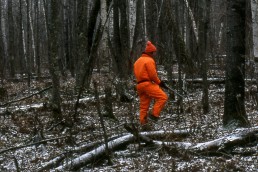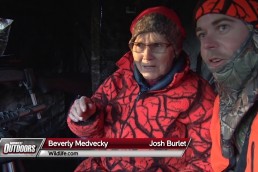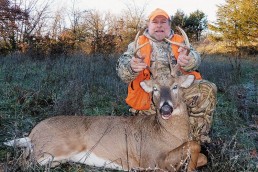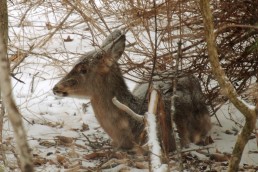Moving Quietly: It Isn’t as Easy as it Sounds
SHARE THIS POST
Moving Quietly when deer hunting
The old “take two steps and stop” routine millions of American still-hunters have been taught is so well ingrained that some hunters become downright irate when I suggest this is not the best way to hunt whitetails. Of course, it occasionally works. But, it mostly fools inexperienced yearlings and fawns. Fooling mature deer is much more difficult than just moving quietly.
Why? Having often wondered about this myself, during my many years of still-hunting, finding the answer became one of my first priorities when I first began my hunting-related whitetail research in 1970. During the following decade, I discovered whitetails knew far more about human footsteps than I imagined.
Two mature does lived close to my usual campsite in my first deer/bear study area in the 1970s. They became so accustomed to my presence (even during hunting seasons) that they and their fawns regularly fed close to my tent. They never abandoned their beds when I approached their bedding areas, if I maintained a distance of 10 to 20 yards. Whenever one of my sons tried approaching them while bedded, the most they saw of these deer were white tails bobbing in the distance. These deer had proven they could distinguish my footsteps from footsteps of other humans.
Careful with their company
My wife and I often photographed about two dozen mature whitetails and their young over a period of 18 years. In two areas in the Texas Panhandle, they remained bedded as we approached them. We were unseen until we appeared at crests of low, wooded ridges adjacent to their bedding areas. While feeding close to our campsites, these deer invariably fled quickly upon hearing footsteps of other approaching humans. They did this year after year, following our usual absence of a year. This proved they also had amazing memories for differences in sounds of footsteps of various humans. This means it is altogether probable whitetails in your hunting area that are 2-1/2 years old or older also readily recognize your footsteps.
Whitetails can easily distinguish sounds of human footsteps from footsteps of other creatures for a number of reasons. For one, bottoms of booted feet of adult hunters are 5-1/2 times larger than hooves of mature bucks and 22-1/2 times larger than hooves of fawns. So, each time a hunter steps down in the woods, he or she is 5-1/2 to 22-1/2 times more likely to step on something that will make a sound than a mature whitetail. And they can easily hear that sound 100 yards or more away. Moving quietly is a lot harder than it sounds!
Genetic advantages
The bottom leathery surfaces of deer hooves can feel whatever they step on. This gives them a distinct advantage when moving quietly. It’s like what you would feel while barefoot or wearing buckskin moccasins. This makes it easy for them to avoid putting enough weight on objects, such as dry branches, to make them snap loudly. Hunters wearing thick-soled boots just can’t do this. Only while trotting or bounding do whitetails snap many branches.
Moreover, being four-legged, deer apply only about 1/4 to 1/2 of their weight on whatever they step on while walking. Humans apply all of their weight on whatever they step on. Human hunters step on larger branches that break more loudly than branches deer step on and break. Typically, branches stepped on by walking whitetails are small. They break so softly that most hunters fail to realize such sounds are coming from deer.
Like a bull in a china shop
While moving quietly (especially while intent on walking without making discernible sounds near an identified hunter) whitetails lift their hooves well clear of the ground and place them down lightly. Humans, accustomed to walking on clean, flat surfaces such as floors and sidewalks, do not ordinarily lift their feet much while hunting. Hunters typically drag their heels and step on or through a multitude of objects. We make noise in grasses, shrubs, fallen leaves, gravel and frozen snow. Humans make sounds characteristic of human footsteps only.
Are you enjoying this post?
You can be among the first to get the latest info on where to go, what to use and how to use it!
Via identifying footsteps alone, a mature, experienced whitetail can also determine whether a human is hunting and currently dangerous, or not likely hunting and currently harmless. If the hunter often halts, it’s likely hunting. Hunters walking nonstop, at a moderate pace, are not perceived as hunting. If a hunter walks along a path that does not lead close to the deer’s current location, a mature whitetail often remains where it stands or is lying down in cover. They freeze to avoid being noticed.
Skillful footfalls can draw deer in
A creature difficult for a mature whitetail to identify via its footsteps that often changes direction and often halts may only be a foraging squirrel or a feeding deer. These sounds may also be a skillfully stalking wolf, bear or human. It could also be a deer sneaking away from a nearby predator or human. Therefore, such footsteps arouse considerable curiosity in a deer. A mature whitetail is unlikely to abandon the area upon hearing footsteps of something it cannot positively identify. However, it remains extra alert and cautious until it identifies the mysterious creature. After a half-hour of silence without incident has passed, the deer will return to normal patterns. (Or after the hunter has reached his or her stand site unidentified).
It is nearly impossible for a hunter, even moving quietly, to walk to a stand site. Mature whitetails within 100 yards will at least occasionally hear the hunter’s identifiable or unidentifiable footsteps. So, the next best thing for a hunter to do is avoid being identified as a “hunting” human. Accomplish this by walking nonstop, at a moderate pace, along a predictable path (such as deer trail), your head pointed straight ahead, even in the dark. Grey wolves commonly use this ruse. A deer near your path ahead usually moves aside, freezes in cover and watches you pass, assessing your behavior. If you don’t appear to be hunting, it remains in the area. It’s likely to be seen near your stand site later.
Know the right steps
To further improve your odds of arriving at your stand site without deer identifying you as a “hunting” human, walk softly. Bend your knees with each step. Lift your foot clear of obstructions on the ground, including grass and leaves. Then, put your foot down lightly. Although this might seem simple, it is not easy for a human to walk this way for long. You have to think about doing it all the way to your stand.
As long as your silhouette is hidden by intervening cover and/or terrain and you are downwind or crosswind of where the deer might be (a feeding area, for example), young and mature whitetails within hearing usually can’t positively identify you via your footsteps. Although, upon hearing some of your soft, nonstop footsteps, those deer remain curious, extra alert and cautious for a half hour. They might move off a bit, but they won’t abandon the area. Your odds of seeing them while stand hunting will improve greatly.
Author notes
Dr. Ken Nordberg has written nearly 900 magazine articles and 13 books on the habits and hunting of whitetails and black bears, including the “Whitetail Hunter’s Almanac” series. He also produced “Doc’s Buck and Bear Hunting School” videos. His encyclopedic website with whitetail hunting tips is at drnordbergondeerhunting.com and his blog is at drnordbergondeerhunting.wordpress.com. Check out his Twitter page @DrNordberg and his presentations at youtube.com/Dr. Ken Nordberg.
Are you a bone collector? Check out our article on finding shed antlers in the late winter!
MWO
SHARE THIS POST
Did you enjoy this post?
You can be among the first to get the latest info on where to go, what to use and how to use it!
Dr. Ken Nordberg
Based on his 55 years of field research, Dr. Ken Nordberg has written more than 800 magazine articles, 12 books on whitetails—including the famous Whitetail Hunter’s Almanac series—five books on black bear hunting and produced Buck and Bear Hunting School videos. You may peruse his encyclopedic website with whitetail hunting tips: drnordbergondeerhunting.com, his blog: drnordbergondeerhunting.wordpress.com, or social media pages.



